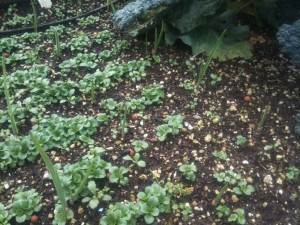See those cute, spoon-shaped leaves? See those sword-green shoots? See how they are growing together? This is not an accident! This is success!
You are looking here at one of my better moments in the quest for the perfect relay between crops, insuring that garden bed will not be bare, even for a moment. While this may seem obsessive….it is! But if obsession doesn’t drive excellence, then I’ll be damned if I know what does. Anyway, as I’ve probably said in a prior post, at least as regards the Noble Rot, garden real estate is at a premium and to have vacant beds means lower productivity AND bad juju.
All that said, I must note that many of my attempts at relay cropping have been less than perfect. In a typical case there is an immature canopy crop, let’s say broccoli, planted at its final, mature spacing, which, at the outset, guarantees lots of open soil space. The gardener striving for excellence (aka the obsessive) seeks to maximize every square inch over every available moment, so he sows something fairly quick-maturing to fill the gaps, such as cilantro, but instead of a perfect cilantro cut just moments before the ever-expanding broccoli forest closes ranks and dominates the bed, it is so much more likely that anemic-looking cilantro will be wheezing and clambering out between the few sun spots left when an unexpected broccoli growth spurt pinched the last nurturing rays of sunlight from the understory cilantro before it could really amount to much.
Not so with the dynamic duo you see before you. Mache, planted in early September, has almost matured to harvest size. Round about October, with the mache barely visible in rows, I inserted garlic cloves at the proper spacing. The cloves slid in among the ranks of the mache with little disturbance and, like any good operative, went completely underground. What’s really lovely here is that the mache’s green carpet relieves the obsessive gardener from the burden of staring at the earth all winter wondering if the garlic is really going to sprout or if the whole space has been completely wasted. And while delighting in the cuddly little mache during the early winter, the gardener can now be pleasantly surprised when – “Bless my soul, what’s this?” – he sees the shoots of garlic coming up as he always knew they would. Then in just a bit more time, the mache comes out, it’s time for a late winter fertilization of the garlic, and then – BAM! POW! KABLOOWIE! – that crop takes off in earnest.
So you see, with enough applied intelligence confirmed by field trials, we really can better our practice and get more crop for less effort. In this regard we’ve got more work to do….quick, Robin, to the Batcave!

